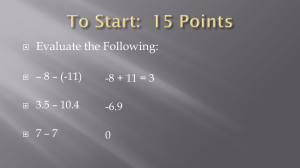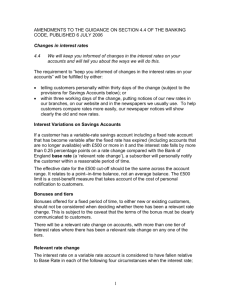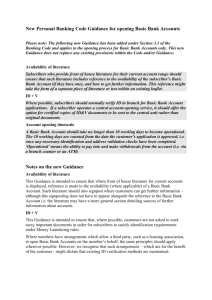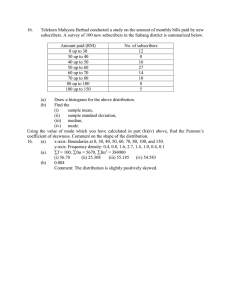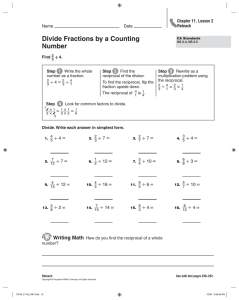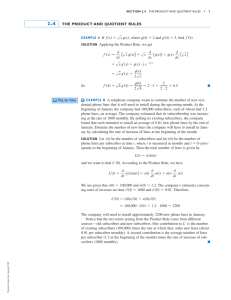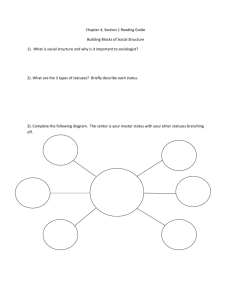RECIPROCAL CAPTIVE INSURANCE COMPANIES AS
advertisement
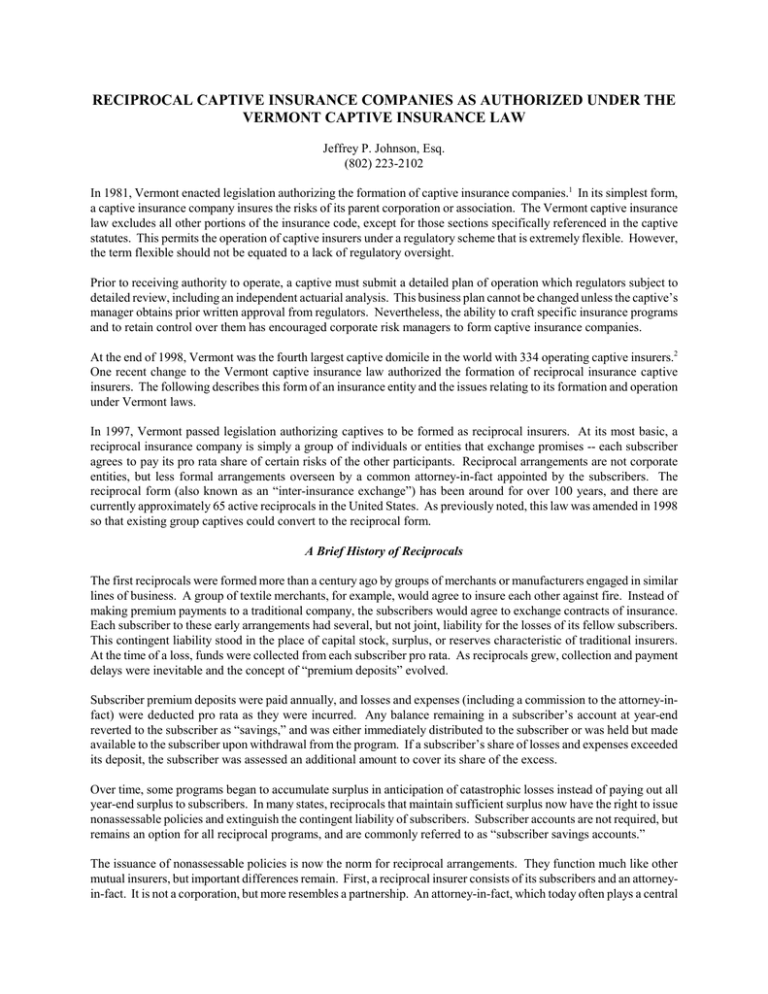
RECIPROCAL CAPTIVE INSURANCE COMPANIES AS AUTHORIZED UNDER THE VERMONT CAPTIVE INSURANCE LAW Jeffrey P. Johnson, Esq. (802) 223-2102 In 1981, Vermont enacted legislation authorizing the formation of captive insurance companies.1 In its simplest form, a captive insurance company insures the risks of its parent corporation or association. The Vermont captive insurance law excludes all other portions of the insurance code, except for those sections specifically referenced in the captive statutes. This permits the operation of captive insurers under a regulatory scheme that is extremely flexible. However, the term flexible should not be equated to a lack of regulatory oversight. Prior to receiving authority to operate, a captive must submit a detailed plan of operation which regulators subject to detailed review, including an independent actuarial analysis. This business plan cannot be changed unless the captive’s manager obtains prior written approval from regulators. Nevertheless, the ability to craft specific insurance programs and to retain control over them has encouraged corporate risk managers to form captive insurance companies. At the end of 1998, Vermont was the fourth largest captive domicile in the world with 334 operating captive insurers.2 One recent change to the Vermont captive insurance law authorized the formation of reciprocal insurance captive insurers. The following describes this form of an insurance entity and the issues relating to its formation and operation under Vermont laws. In 1997, Vermont passed legislation authorizing captives to be formed as reciprocal insurers. At its most basic, a reciprocal insurance company is simply a group of individuals or entities that exchange promises -- each subscriber agrees to pay its pro rata share of certain risks of the other participants. Reciprocal arrangements are not corporate entities, but less formal arrangements overseen by a common attorney-in-fact appointed by the subscribers. The reciprocal form (also known as an “inter-insurance exchange”) has been around for over 100 years, and there are currently approximately 65 active reciprocals in the United States. As previously noted, this law was amended in 1998 so that existing group captives could convert to the reciprocal form. A Brief History of Reciprocals The first reciprocals were formed more than a century ago by groups of merchants or manufacturers engaged in similar lines of business. A group of textile merchants, for example, would agree to insure each other against fire. Instead of making premium payments to a traditional company, the subscribers would agree to exchange contracts of insurance. Each subscriber to these early arrangements had several, but not joint, liability for the losses of its fellow subscribers. This contingent liability stood in the place of capital stock, surplus, or reserves characteristic of traditional insurers. At the time of a loss, funds were collected from each subscriber pro rata. As reciprocals grew, collection and payment delays were inevitable and the concept of “premium deposits” evolved. Subscriber premium deposits were paid annually, and losses and expenses (including a commission to the attorney-infact) were deducted pro rata as they were incurred. Any balance remaining in a subscriber’s account at year-end reverted to the subscriber as “savings,” and was either immediately distributed to the subscriber or was held but made available to the subscriber upon withdrawal from the program. If a subscriber’s share of losses and expenses exceeded its deposit, the subscriber was assessed an additional amount to cover its share of the excess. Over time, some programs began to accumulate surplus in anticipation of catastrophic losses instead of paying out all year-end surplus to subscribers. In many states, reciprocals that maintain sufficient surplus now have the right to issue nonassessable policies and extinguish the contingent liability of subscribers. Subscriber accounts are not required, but remains an option for all reciprocal programs, and are commonly referred to as “subscriber savings accounts.” The issuance of nonassessable policies is now the norm for reciprocal arrangements. They function much like other mutual insurers, but important differences remain. First, a reciprocal insurer consists of its subscribers and an attorneyin-fact. It is not a corporation, but more resembles a partnership. An attorney-in-fact, which today often plays a central and entrepreneurial role, manages the day-to-day insurance functions of the reciprocal, and a subscriber’s advisory committee supervises the attorney-in-fact and the reciprocal’s finances and operations. Tax Considerations Conversion to Reciprocal. The first tax issue for consideration is whether a company could accomplish conversion from a C Corporation to a reciprocal on a tax-free basis pursuant to Section 368 of the Internal Revenue Code. That section defines a reorganization to include a statutory merger or consolidation; the acquisition by one corporation, in exchange for voting stock, of the stock or assets of another corporation; recapitalization; a mere change in identity, form or place of organization of a corporation; or a transfer pursuant to bankruptcy. Vermont law permits conversion of a corporation into the reciprocal form. However, that specific statute has not been tested in terms of its compliance with Section 368 requirements. Operation of Reciprocal. As a general rule, reciprocals are taxed on an ongoing basis the same as mutual insurance companies.3 There is, however, one important rule applicable to reciprocals found in Section 832(f). It provides that a reciprocal may deduct amounts credited to subscribers’ savings accounts, even if such amounts are not actually paid out. This provision permits reciprocals to accumulate earnings on a tax-free basis. A reciprocal, which credits its yearend earnings to individual subscriber savings accounts before the 16th day of the third month following the close of a tax year, may take a full deduction for such credits provided the company would be obligated to pay the subscriber such amount “promptly” upon termination from the program. The allocation of earnings to a subscriber savings account is a taxable event to the subscriber at the time of such allocation. For subscribers that deduct insurance premiums for tax purposes, any amount credited to the subscriber savings account is includable at the time the credit is made. In the case of subscribers that are non-profit entities, the amounts credited to the subscriber’s savings account(s) would not be taxable. Provided the company allocates earnings to non-profit subscribers, it may be possible to avoid virtually all federal income tax liability on its Vermont operations. Administration and Governance One of the advantages of the reciprocal form is the high degree of flexibility with respect to structure and governance. The rights and powers of the attorney-in-fact are set forth in a power-of-attorney given by the subscribers. The powerof-attorney must set forth the specific powers of the attorney-in-fact, the general services to be performed, provisions for compensation and expenses, and for assessable programs, provisions regarding the contingent liability of subscribers and a specific assessable amount (at least equal to the subscriber’s premium deposit and not exceeding ten times that amount).4 The power-of-attorney may set forth other provisions, including provisions for substitution of the attorney, restrictions on the exercise of the attorney’s powers, the reservation of rights to the subscribers’ advisory committee, and other lawful advisable provisions.5 In addition to the power-of-attorney, most reciprocals utilize a separate subscribers’ agreement and so-called “rules and regulations” establishing the rules under which the subscribers’ advisory committee is selected and other rights of the subscribers including, for example, whether the company will utilize subscriber savings accounts. Under Vermont law, two-thirds of the members of the subscribers’ advisory committee must be subscribers, none of whom may be the attorney-in-fact or any person connected with that entity. The committee has responsibility for supervising the finances of the company, assuring compliance with the subscribers’ agreement and power-of-attorney, and procuring the audit of the accounts and records of the insurer and the attorney-in-fact. The subscribers’ agreement may set forth additional powers and functions.6 In sum, the statutory requirements with respect to the power-of-attorney and subscribers’ agreement are minimal and basic, creating a high degree of flexibility in administration and governance. A company could, for example, establish different classes of subscribers and use whatever methodology it deems advisable to make allocations to subscriber savings accounts. Ownership and Distributional Interests If the company is currently a stock corporation, ownership interests could be converted into the interests of the subscribers of the reciprocal at the time of the conversion to a reciprocal. In general terms, subscribers’ ownership interests could be reflected in either surplus accounts (based on surplus contributions) or subscriber savings accounts in which the retained earnings of the reciprocal accumulate on a tax-free basis. Reciprocal distribution rights may be structured according to whatever formula the participants select. Allocations may be made into a particular subscriber savings account based on premium volume, loss experience, surplus contribution, or any other reasonable formula adopted by the participants. This flexibility would permit a company to structure its programs so that existing ownership rights are respected, and that earnings are allocated primarily to non-profit founding members not subject to federal income taxation. Risk-Sharing Vermont law defines “reciprocal insurance” as that “resulting from an interchange among persons, known as subscribers, of reciprocal agreements of indemnity, the interchange being effectuated through an attorney-in-fact, to all such persons.”7 Because of the required reciprocity, it is imperative that a Vermont reciprocal involve true risk-sharing among its subscribers. Attorney-In-Fact As mentioned above, a Vermont reciprocal is required to have an attorney-in-fact common to all of its subscribers. The subscribers, together with their attorney-in-fact, “comprise a reciprocal insurer and a single entity as to all operations under the insurer’s certificate of authority.”8 The attorney-in-fact for a Vermont reciprocal must maintain its principal office in Vermont.9 At the time of filing an application with the Vermont Department for reciprocal status, the attorney-in-fact must provide a fidelity bond in the amount of $250,000 in favor of the State of Vermont for the benefit of all persons who may be damaged as a result of any breach by the attorney. The specific duties and responsibilities of the attorney-in-fact are spelled out in a power-of-attorney setting forth the attorney’s authority, the general services to be performed, and the maximum amount to be deducted from premiums or deposits to be paid to the attorney, those expenses to be paid by the insurer. In addition, the power-of-attorney may set forth provisions regarding substitutions, restrictions on powers, and any other advisable provisions.10 Although Vermont does not specifically regulate the conduct of reciprocal attorneys-in-fact, the NAIC has developed a model “Reciprocal Attorney-in-Fact Model Act” which provides for comprehensive regulation of reciprocals. The Act purports to require licensure of each attorney-in-fact for any subscriber whose risk is located in a particular state. Any state with the Model Act may require a bond of the attorney-in-fact, or errors and omissions coverage. The model further requires certain standards for the subscribers’ advisory committee, including that it consist of not less than nine individuals and meet at least annually. The Model Act establishes quorum and notice requirements for subscriber meetings, and establishes investment guidelines, accounting procedures, and underwriting procedures. In addition, the Act purports to subject reciprocals and attorneys-in-fact to provisions analogous to those contained in the Holding Company Act (30-day prior approval for all material transactions between the reciprocal, its subscribers, the attorney-infact, and any affiliate of the attorney-in-fact). Finally, the Act subjects the attorney-in-fact to examination, the cost to be assessed against the attorney-in-fact with no portion thereof being reimbursed directly or indirectly by the reciprocal or its subscribers. To our knowledge, only two states, Colorado and Alaska, have adopted the NAIC Model. Organization of Vermont Captive Reciprocal Two or more persons may organize a domestic captive reciprocal and make application to the Commissioner for a certificate of authority to transact business. In addition to the information currently required in the captive application process, the organizers must also, in conjunction with the proposed attorney-in-fact, provide the following: the names and addresses of the original subscribers; a copy of the power-of-attorney; the names and addresses of the officers and directors of the attorney-in-fact; the powers of the subscribers’ advisory committee; and the names and terms of office of the initial members of the subscribers’ advisory committee.11 Upon approval, a certificate of authority is issued to the attorney-in-fact in the name of the reciprocal.12 Conclusion Vermont has seen the formation of five new captive reciprocal insurers. Medical and hospital organizations have primarily, although not exclusively, been the entities forming reciprocals. As non-profits, they enjoy the benefits of the captive insurance form without having to pay significant federal income taxes on the revenue realized by their captives. Because of this benefit, there have also been conversions from other forms of captive companies to the reciprocal form. We expect that the formation and conversion of captives to reciprocals will continue as word of the favorable tax consequences is more broadly heard. Endnotes 1. 8 V.S.A. Chap. 141 §§ 6001-6020. 2. Business Insurance, April 12, 1999, p. 3. 3. 26 U.S.C. § 831(a). 4. Id. § 4838(c). 5. Id. § 4838(c). 6. Id. § 4847. 7. 8 V.S.A. § 4831(2). 8. 8 V.S.A. § 4835. 9. 8 V.S.A. § 4836(b)(2). 10. 8 V.S.A. § 4838. 11. 8 V.S.A. § 4836. 12. Id. § 4837.
